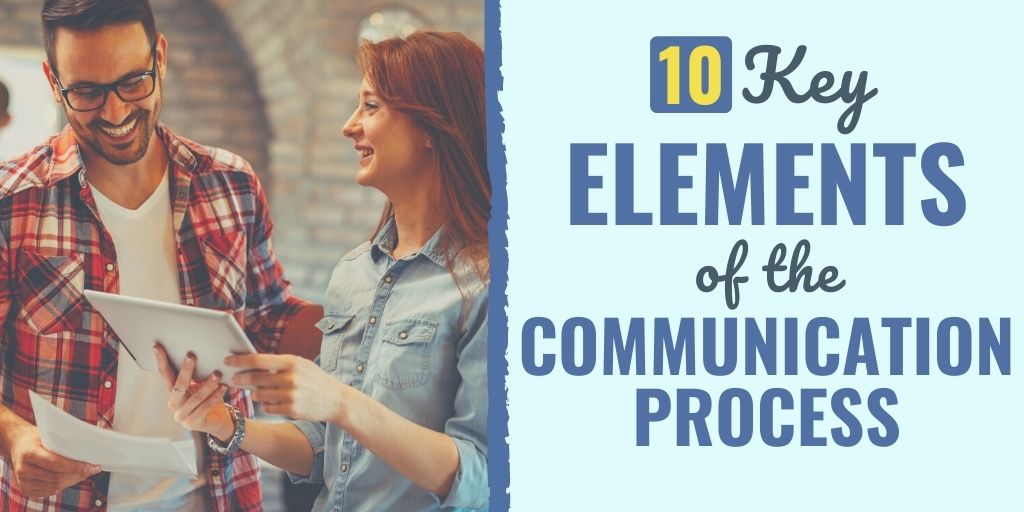There might be affiliate links on this page, which means we get a small commission of anything you buy. As an Amazon Associate we earn from qualifying purchases. Please do your own research before making any online purchase.
Opportunities to improve communication exist, from learning to be a better listener to being assertive in your communication. But understanding the key elements of communication is sure to help you improve communication skills. Plus, you’ll be able to see a greater impact on your relationships, than simply brushing up on those skills alone.
What happens when communication breaks down? You’re not connecting with friends and family? There seems to be something missing? For whatever reason, what you’re saying doesn’t click or resonate with others.
When that happens, it helps to understand the elements of communication. In this post, you’ll learn why messages are created, how they’re received, and how they’re interpreted. Then, you’ll dive into the barriers of communication. Finally, you will learn how those barriers interfere with your ability to communicate effectively.
What is the Communication Process?
The communication process is a set of actions meant to increase the understanding of messages. The thoughts and ideas in a message are translated into specific details and transmitted through a channel to the recipient, who then deciphers the meaning of the message before offering a response.
Communication that’s interpreted properly will rely on nonverbal cues (body language, mannerisms, and eye contact) and verbal speech, both of which are intended to ensure the recipient of the message accurately receives what you are attempting to convey.
As the sender, your job is to make communication effective. You have plenty of control over how your messages are transmitted, how they’re received, and even how they’re understood. But the process of improving communication skills takes time.
Before you can set S.M.A.R.T. goals for improving communication, you will first want to develop an understanding of what it means to communicate effectively. That is, coherently, clearly, and in a way that’s understood and not subject to misinterpretation. You need a set of principles to follow to make sure your messages are well-received. Start by learning why communication is so important.
Why is Effective Communication So Important?
The primary benefit of effective communication is increased understanding of ideas. With clear communication, there will be people who follow instructions as well as recipients of messages who respond in kind. You can expect your relationships to get stronger and for people to trust what you have to say.

Whether you’re a student, volunteer, or executive… effective communication means you get your point across when it counts most. This also means that it is done without misinterpretations, uncertainty, confusion, or resistance.
Here are some strategies to help ensure effective communication:
Effective communication requires years of commitment to get right. From the changing technological landscape to the significance of climate change, the way people communicate can set others up for success.
If you know how to communicate effectively, in personal situations, you’ll see more opportunities to grow closer with others. While in professional circumstances, effective communication means you’ll get promoted, be taken seriously, and be rewarded with additional responsibilities in the work environment.
Effective communication happens to put people in a position to improve their communication skills. Yes, you can improve your communication skills for life if you acknowledge the elements of communication.
The 10 Elements of Communication
Learning the ten elements of communication puts you in the driver’s seat as a communicator. Whether confident or uncertain, you’ll find yourself empowered to improve your communication skills at every step of the way.
Improving communication is a lifelong challenge. But it’s a challenge that gets better when you’re sure to embrace the basics.
1. Sender
The sender is the source that starts communication. The sender imagines the message, and then considers how to transmit it to the receiver. The sender refers to previously established ideas, earlier discussions, memories, current needs, and anything else relevant to the most recent communication that’s to be sent.
As the sender is placed at the beginning of the communication process, it’s crucial to hold off on nonverbal cues and body language. The sender concentrates only on the initial idea behind the communication.
2. Encoding
After forming a message, the sender must find tangible ways to turn thoughts into communication. Messages make sense when the ideas behind them are presented in a form that’s ready to be transmitted.
Before messages are made, the sender uses gestures, pictures, words, and symbols to communicate thoughts and ideas. These additions serve to provide the receiver with communication that’s easily understood.
3. Message
In many ways, society depends on messages being communicated between senders and receivers. Messages consist of ideas that are broken down into details. These details are meant to be understood, but only when the people communicating can analyze both verbal and nonverbal cues.

Various institutions and people depend on the transmission of messages. Managers in the workplace send instructions through messages to entry-level employees. A parent may use verbal instructions to send a message to a child to stop a behavior. In both instances, the messages are formed around one or more thoughts.
4. Channel
Channels are outlets that senders use to transmit messages.
For example, if the sender is the public speaker, then the channel is the medium through which the speaker transmits messages (lecture, presentation, or demonstration).
But as modern technology evolves, there are more channels available than ever. Here are some channels people can use to transmit messages:
5. Receiver
The receiver is the person who engages with the message to find meaning. The more resources the receiver has to interpret a message, the clearer that message will be received, and the greater likelihood that interpretation of the message will be accurate.
The receiver may also find that one message is connected to another and that complete interpretation of one message means developing an understanding of two or three.
Being a receiver of messages is what humans must do to maintain their sense of humanity and connection to others.
6. Decoding
The gestures, pictures, and words used to encode a message are used by the receiver to decode the message. Once the receiver has the message, a process of interpretation begins where the receiver first receives the message before it’s analyzed by the brain for the purpose of assigning meaning.
Think of a text message you get on your smartphone that immediately catches your attention. Only after your brain interpreted the message as a warning or alarm did you come to develop some meaning behind the message. Without being able to decode the message, you’d have no other elements of communication, such as body language to help you assign meaning to the message. Therefore, if you’re the receiver, taking time to properly decode a message has a major impact on your ability to communicate with others.
7. Environment
Your environment consists of your immediate surroundings. The furniture, décor, and possessions in your apartment. The more open, fresh, and flexible the environment, the better. For that reason, you might even consider how to get organized and become efficient.
Meanwhile, if you've ever had trouble communicating with someone, especially when you felt that the environment wasn’t quite right, then you know that the impact the environment makes on communication is unmistakable. For example:
8. Interference
Interference refers to the obstacles to effective communication. The interference refers to one or more types of noise: physiological, organizational, cultural, technical, or psychological noise.
Whether you’re the sender or receiver, the interference can come as a result of limitations in your own physical abilities, the inability to use a failed technological device, or even the organizational boundaries that exist between employees in a workforce. An assessment of how interference impacts your communication is vital to improving the way you speak with and connect with others.
9. Context
The context includes the setting and circumstances surrounding the situation where the communication takes place. If you think of the context of a conversation with a friend, you think of why you’re discussing what you are, what you hope to get out of the conversation, and what circumstances led to the chat. Combined, these takeaways amount to context, one of the elements of communication which adds meaning to the conversations and discussions you have.

In a conversation, the person speaking might consider the context to determine how to respond to a question, determine hidden meaning, or identify a clever way of responding to a statement. So, context can provide those communicating with a better way of sharing a specific point, particularly when the details are discussed by all parties.
10. Feedback
Feedback refers to a verbal or nonverbal response. Particularly, the kind of response you give after receiving and decoding a message. Feedback can take the form of an answer to a question. Or it can be feedback in response to a general statement. Either way, the receiver’s response to the sender clears up any misunderstandings, and then clarifies any small details that have yet to be refined.
As the sender, you can use feedback you get from work, then implement it to be more productive. Both the sender and receiver need feedback to believe their communications are effective. The absence of this feedback creates feelings of hostility and resentment. Either of these responses can interfere with existing communication.
Fortunately, introducing feedback into your conversations will help you connect to communication. Whether emotionally or analytically, feedback provides both sender and receiver with the opportunity to learn and understand.
Acknowledging the Elements of Communication to Improve Communication Skills
In personal and professional settings, you can improve your communication skills. That means learning why and how thoughts are broken down into messages. From the creation of a message during encoding to the deciphering of its meaning during decoding, the terminology that’s used will make you think harder about how you’re communicating.
If you think harder about what you say and why you say it, you’ll see that the receiver decoding your messages may have as much of a responsibility while communicating as you do.
Improving your skills means being a better listener and learning to offer feedback where appropriate. The elements of communication form a system that you can use to improve. Think not merely about what you say, but about each and every aspect of the communication process. Improvement will come, as any flaws in your communication skills become more evident as you gain insight into the process.
Understanding Barriers to Communication
The ability to communicate is essential to daily life. The barriers to communication prevent the sender and receiver from sustaining and initiating communication. Meanwhile, existing barriers create additional conflicts, many of which degrade the elements which keep communication effective. Should you find evidence that something is interfering with your communication, it’s likely one of these five barriers is the cause.
Interpersonal barriers
The meaning of ‘interpersonal’ is something between people. Interpersonal barriers often revolve around the conflicts that exist between two people.
With that in mind, think of interpersonal barriers, such as unwillingness to listen, resentment between sender and receiver, or inability to trust, as walls in place that prevent sender and receiver from appreciating and accepting new ideas. Interpersonal barriers to communication often hit you where your heart is.
Physical barriers
Physical barriers to communication include tangible items that interfere with how messages are transmitted and received. These barriers could include practical items in your surroundings like walls, doors, barriers, or gates.
At a government or law enforcement facility, an example of a physical barrier might include a password or key phrase that restricts access to specific employees.
Physical barriers can also include technology that’s defective or broken, and thus can’t be used to communicate effectively. Much like a damaged USB device might prevent a student from submitting an assignment to an instructor, any medium of communication that’s rendered useless inhibits the sender’s ability to send the message.
Emotional barriers
To be an effective communicator, your emotions should strengthen your communication.
But emotional barriers interfere with your ability to communicate freely with others. Research shows that emotional barriers exist in schools where the classroom is centered on a small number of confident students. Negative feelings like anger and pride get in the way. Thus, an emotional barrier to communication is created.
Your tone of voice and body language influence how the message is interpreted. Whereas most people can easily sense anger and pride, anxiety amid communication may make the less overwhelmed speaker feel frustrated. Therefore, a continued conversation requires the management of emotions. Beginning with understanding how those emotions interfere with communication.
Language barriers
Foreign language is the most commonly thought of language barrier. But dialects, a form of language specific to a certain region or group, and accents, a distinct pronunciation of the language, both have just as much effect on communication. As does jargon and even slang, which can come across as foreign to many people.
The sender of a conversation may use a language the receiver doesn’t understand. The barrier that exists prevents sustainable communication. That's even with patience and persistence to go along with it. Still, throughout a neighborhood, community, state, or region, the use of foreign languages is common.
In the workplace or community, language barriers can be troublesome. Being open to learning new languages is essential for neighbors and employees alike. Both of which have as much right to communicate like anyone else.
Cultural barriers
In communities and workplaces, there is a need to accept those with beliefs, morals, ideals, and values that differ from what others are familiar with.
In a workplace environment, the way people eat, dress, and behave can make communication more difficult. Especially if language barriers and stereotypes are apparent in an organization.
Stereotypes, for example, are preconceived and often negative ideas people develop about a certain group of people. Stereotypes can make communication difficult.
Meanwhile, nonverbal communication can have wildly different interpretations. While eye contact may symbolize confidence in the West, your gaze might come across as obnoxious in Asia. Then, in some parts of the world, assigned seating exists. But interestingly, the Japanese don’t like showing emotion in their facial expressions, as they fear overburdening the people they communicate with.
So clearly, cultural barriers exist. However, more communities implement practices meant to improve relations with those in the area. Including those with beliefs and values that are different than what everyone's accustomed to seeing.
Final Thoughts on Elements of the Communication Process
The next time you’re having a conversation, think about the elements of communication. Think of how you break your thoughts down into messages. Then, focus on how you use nonverbal body language to increase understanding.
The barriers of communication may make staying in touch with others more difficult. But to improve communication skills, being open to new ideas is essential. Effective communication is one of the most important techniques you can learn.
Now that you know about the elements of communication, you can improve your interpersonal skills to have better and more effective conversations. Starting today, commit to keeping these elements in mind while improving upon your interpersonal skills. Then, focus your attention on building stronger relationships in the future.


